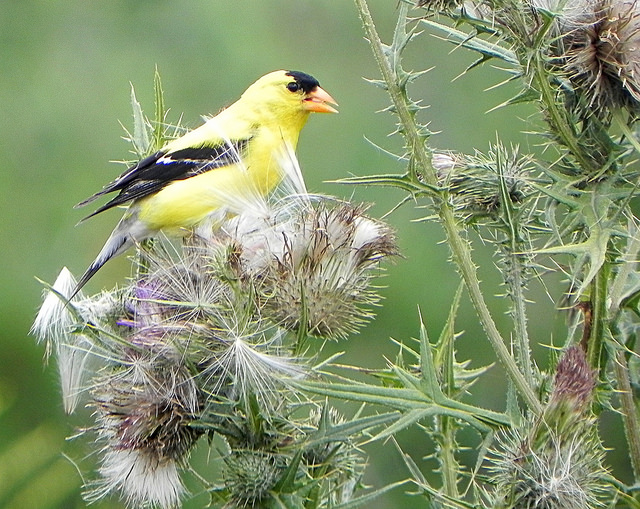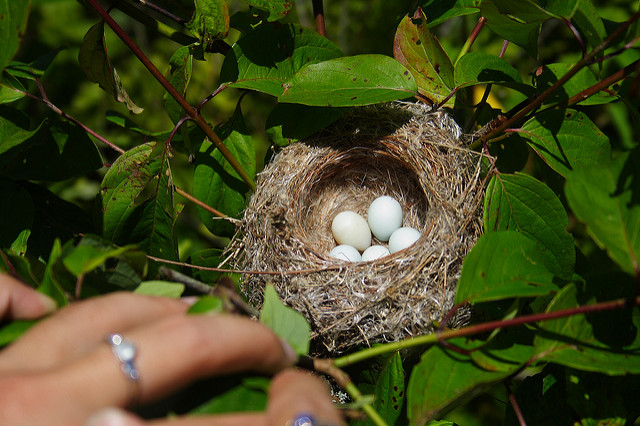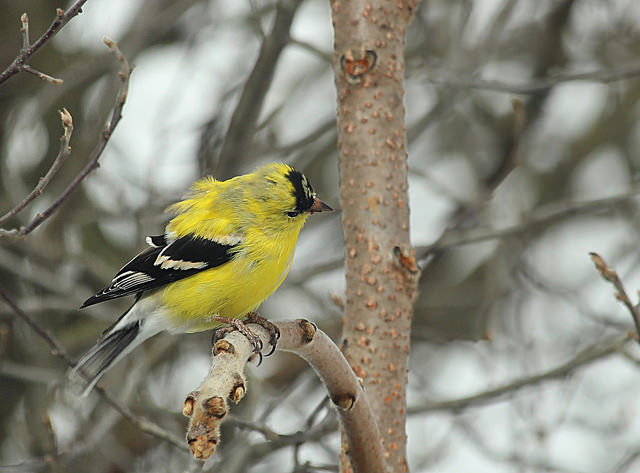Since the unusually warm days in late February when turtles basked in the sun, fuzzy Pussy Willows peeked out of their hard brown buds and green spikes of daylilies pierced the unfrozen ground I’ve been looking for more signs of spring.
A friend of mine said spring in Western NY and PA is like being a Buffalo Bills fan. Your get your hopes up and then they are dashed. We have warm days followed by single digits. Sunshine followed by white-out snow.
But spring is coming none-the-less. Our feathered friends are sure of it. Early arrivals such as Red-winged Blackbirds and Turkey Vultures have been spotted returning from their winter grounds. There are birds that remain in this region year round who change with the coming of spring too. One of them is the American Goldfinch.
I have an affinity for finches because we share a name. I didn’t pay my last name much heed until I started working at Audubon, an organization founded to protect birds and their habitats. One of life’s funny little coincidences. Also note we have volunteers with the last names of Feather and Bird.
The American Goldfinch is a common bird across North America. A frequent visitor of feeders, they prefer the small seeds of thistle but will also feed on sunflower seeds. And how can one miss the brilliant gold and contrasting black of the male in breeding plumage in the spring and summer? While watching birds at the feeder, a student said the goldfinch looks like it was colored with a yellow highlighter and black sharpie. Or it looks like a Pittsburgh Steeler.

Male goldfinch in full breeding plumage picking seed or down from thistle. Photo by Jeff Tome.
But have you ever noticed the male goldfinch getting to that brilliant outfit? He does not suddenly appear dressed in black cape and cap. It is a process. A transition. Like many transitions in life, it can appear slightly awkward.
In the fall, both male and female goldfinches go through a complete molt, which means they drop all their old feathers and grow in new ones. They don’t do this all at once but gradually, so they can continue to move around, feed and stay warm. So there is a time when they look fuzzy and mottled in color as new feathers grow in. In this molt, the male turns from brilliant gold and black to a more drab yellow, olive and gray. A bit of a crossdresser, the male looks very much like the female throughout the winter. No need to impress the girls with fancy dress then.
But as winter fades, so does the males’ drab color. This time of year, they gradually molt again but only partially. They keep the wing and tail feathers but replace their body and head feathers. This is when the male gets highlighter yellow to attract a mate.
But as the spring goes on, the males really show their true colors. Rather than replace their wing and tail, the feathers in these parts actually fade. The drab winter colors break down to reveal the bright white wing bar. It is a reverse fade. Rather than fading from bright to dull like construction paper in a sunny window, they fade from dull to bright. And blacker. By the end of summer, male goldfinch wings can be mostly black.

Hidden among the shrubby landscape, goldfinch nests are woven tight enough to hold water. Photo by Jennifer Schlick
What I find equally intriguing, is that male goldfinches start this plumage change in late winter. In mid-spring, they start their long, warbling calls, elaborate flights and chasing. All of this is done to attract a female. They pair up but then the love birds appear to halt the reproductive process. Goldfinches are one of the latest nesting birds. They don’t start nest building and egg laying until July, a time when most other song birds are teaching their young to fly.
The late nest building is understandable. Goldfinches eat mostly seeds. They delay nesting until plants such as thistle, grass, birch and dandelion have set their seeds. They use the fluffy down of cattail and thistle to build their nest as well. They can’t start building until the materials are available and the fuel for the hard work of reproducing and raising young is ripe. But why start the courtship rituals so early? Why not wait until early summer to sing and dance and get a mate? I wonder if they have the longest “dating” period in the bird world.
Goldfinches changing color is certainly a sign of spring. But they also bring up unanswered questions. As I watched the birds at the thistle feeder in the past few weeks, the more I learned. The more I learned, the more I questioned. And questions are what leads us to discoveries.
In goldfinches we can honor the in between. We so often see things in their finished state and think that is the way they have always been. Or we see the before and after pictures, but not the process it took to get there. We don’t see the work, the awkwardness, the starting and stopping, the little celebrations, the going backwards, the wrong turns, setbacks and mistakes. Basically, we don’t see the mess. In goldfinches, as well as this gradual approach to spring, we can witness this awkward but oh-so-necessary change occurring right before our eyes.
Audubon Community Nature Center builds and nurtures the connections between people and nature. The trails are open for hiking or skiing from dawn to dusk and the Nature Center is open from 10 a.m. – 4:30 p.m. daily except Sundays when it opens at 1 p.m. Visit auduboncnc.org for more information or call (716) 569-2345.
Katie Finch is a naturalist at ACNC.


Recent Comments